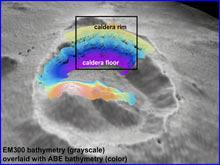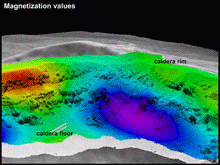ABE high resolution bathymetry (color - 2 meter grid-cell size) overlaid on EM300 bathymetry (grayscale - 25 meter grid-cell size) at Brothers volcano. 1.5 times vertical exaggeration. The view is from the southeast looking toward the northwest. The box represents the area where the ABE scientific data were collected, including magnetics, Eh and temperature anomaly data shown in the following images. Click image for larger view and image credit.
View a slideshow of ABE high resolution bathymetry overlaid on EM300 bathymetry at Brothers volcano. Three dimensional views are from the southeast looking toward the northwest of crust magnetization, Eh anomaly values, and hydrothermal temperature anomalies. Data sets like this give scientist a greater understanding of the natural world.
![]() Click image to view a slide show.
Click image to view a slide show.
Viewing Nature's Patterns at a Submarine Volcano
August 10, 2007
Bob Embley
Chief Scientist
New Zealand American Submarine Ring of Fire 2007 Expedition
Geophysicist
NOAA Vents Program, Pacific Marine Environmental Laboratory – Newport, Oregon
AUVs are starting to make significant impacts on ocean research and exploration because they operate independently of surface control. This frees up the research vessel for other tasks. Of equal importance, however, they provide scientists with the ability to conduct near-bottom mapping with unprecedented detail and maximum efficiency. Prior to the development of reliable AUVs, near-bottom mapping was conducted using instruments towed behind ships on long cables near the seafloor. Most of the scientific instrumentation used on towed systems has now been adapted to AUVs. We are fortunate to be collaborating with the ABE program for this project because of their broad experience of working with scientists.
Scientists are constantly looking for patterns that help them understand how things work in the natural world. At Brothers Volcano, we are searching for patterns by using computer techniques that enhance our ability to make rapid comparisons of different data sets. For example, a 3-D visioning exploration program (Fledermaus) can “drape” multiple layers of data collected by ABE over the volcano topography. On this expedition we are fortunate to have Susan Merle with us, a resident expert on using this software. Susan takes the data collected from ABE’s various sensors and imports it into the software package. The seafloor depth data forms the “base” layer over which other types of data (e.g., magnetic field, water temperature, chemical anomalies) are draped in layers. Several of these layers can be stacked on one another and either viewed separately or in combination. The figure shows crustal magnetization, a hydrothermal chemical anomaly known as “Eh”, and the hydrothermal temperature anomalies as individual layers draped on the rugged ABE high resolution topography of the northern wall of Brothers volcano. Note the correspondence between the “Eh” and the magnetic signature. Weaker magnetic signatures appear to correlate with increased Eh and temperature anomalies. Why is this?
From studies of hot springs (geothermal areas) on continents and on other areas of the seafloor, we know that hot, acidic hydrothermal fluids (with high Eh anomalies) rising through hot springs can dramatically alter the surrounding rocks by stripping out some elements and depositing others. After a period of time these rocks are transformed from a hard crystalline rock to a soft claylike rock. The magnetic signature that was locked into the rock during its formation is significantly reduced as a result, and this weak magnetic signature will remain even after the hot spring becomes extinct. Comparing the distribution of rock magnetism with the chemistry and temperature of the discharging vent fluids will allow us to identify both extinct and active hydrothermal vent zones.


















